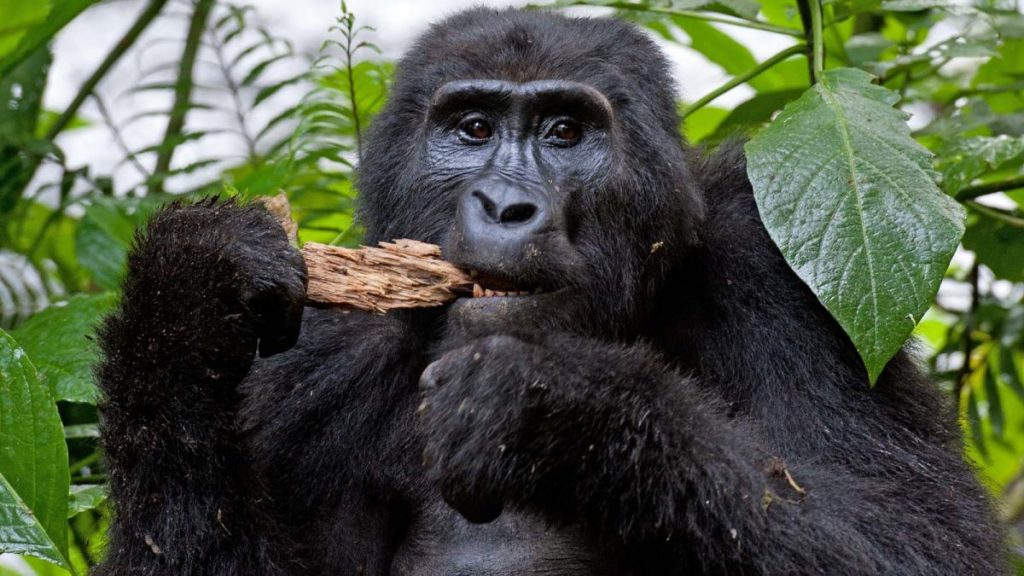CAN GORILLAS EAT MEAT?
- Home
- CAN GORILLAS EAT MEAT?
CAN GORILLAS EAT MEAT?


Many travelers often wonder — can gorillas eat meat? The simple answer is no, gorillas are primarily herbivores. Their diet mainly consists of leaves, stems, fruits, bamboo shoots, and roots found in the lush rainforests of Uganda, Rwanda, and the Congo Basin. You might have come across some posts claiming that they do, but perhaps it’s time you unlearn that fallacy. Gorillas dominate their presence in East and Central Africa. This region has a wide cover of tropical rainforests which is bordered by some tracings of montane vegetation. Gorillas are one of the world’s largest primate species. Whereas their intestines have some similarities with those of humans, theirs are more extended with some similar features of cud chewing mammals.
Another important aspect is to do with their body shape and character. Gorillas grow so strong and subsequently heavy with adulthood. The notion of them eating meat gives some people the impression that they have hunting instincts. Generally, hunting mammals are fast in their movements to get closer to the prey. The gorilla’s bodies can only do as much. Their speeds are so average at that. Their sharp teeth deserve as far as they have to harvest thick stems for feeding with ease.
However, a close look at a more scientific explanation shows that gorillas require Vitamin B12 to enhance their stable looks. This vitamin is only attainable from the non- chlorinated water washed vegetation. Their large intestines (when compared to humans) have the required characteristics to digest the shoots and heavy leaves they feed on. This makes them herbivores. They sometimes also feast on small insects especially ants and termites. Their long intestines enable a robust digestion of heavy leaves from which they squeeze and absorb amino acids.
These are protein fluids similar to what a human would attain when they eat and digest meat. This is the reason for their strong body build which requires much protein to acquire. A misunderstanding comes at the sight of their protruding fangs when open their mouths. It should be noted thereof, that the digestive importance of those large teeth is to prune and tear the shoots of the bamboos on which they feed.
Gorillas, although having much DNA similarities with humans shouldn’t also lead one into drawing a final conclusion of being meat eaters. These primates averagely on a daily basis consume large amounts of fruits and other plants up to about 20 kilograms.
This should be a balanced meal in order to maintain such massive strengths. As an addition, the cellulose they draw from the vegetation they eat contributes to their strength. They literally like plants with much fiber. Ever wondered what keeps their skin glittering? That the work of the many fruits they eat. They often gather ripe fruits more.
Research samples collected from their digestive wastes shows some contents of animal DNA especially somewhat similar to that of monkeys. However, that’s not truly a translation that they feed on monkeys. Further studies show that this accounts for the variety of insects they feed on once in a while. Lastly, the tourist can do some more research to further appreciate these debunking facts of the proverbial fallacy that gorillas eat meat.
What Do Gorillas Really Eat?
Gorillas spend most of their day feeding on vegetation. Mountain gorillas, found in Bwindi Impenetrable and Mgahinga Gorilla National Parks, eat up to 30 kilograms of plants daily.
Lowland gorillas enjoy more fruit and occasionally small insects like ants or termites, but they don’t hunt or eat meat like chimpanzees do.
Why Gorillas Don’t Eat Meat?
Gorillas have a large, plant-adapted digestive system that helps them break down fibrous vegetation efficiently. Their calm, gentle behavior and slow movements match their peaceful vegetarian lifestyle, one reason they are known as the gentle giants of the forest.
Experience Gorilla Feeding Behavior in Uganda
During a gorilla trekking safari in Uganda, you’ll observe these incredible creatures up close — watching how they feed, play, and interact within their family groups. It’s a remarkable wildlife encounter that supports conservation and community tourism.
Book your gorilla trekking experience with Uganda Gorilla Vacations today and learn fascinating facts about gorillas in their natural habitat
